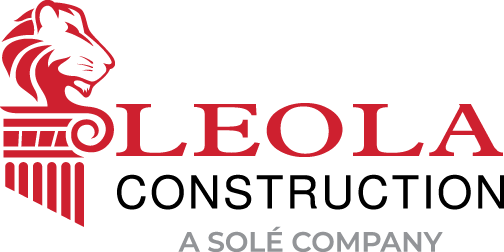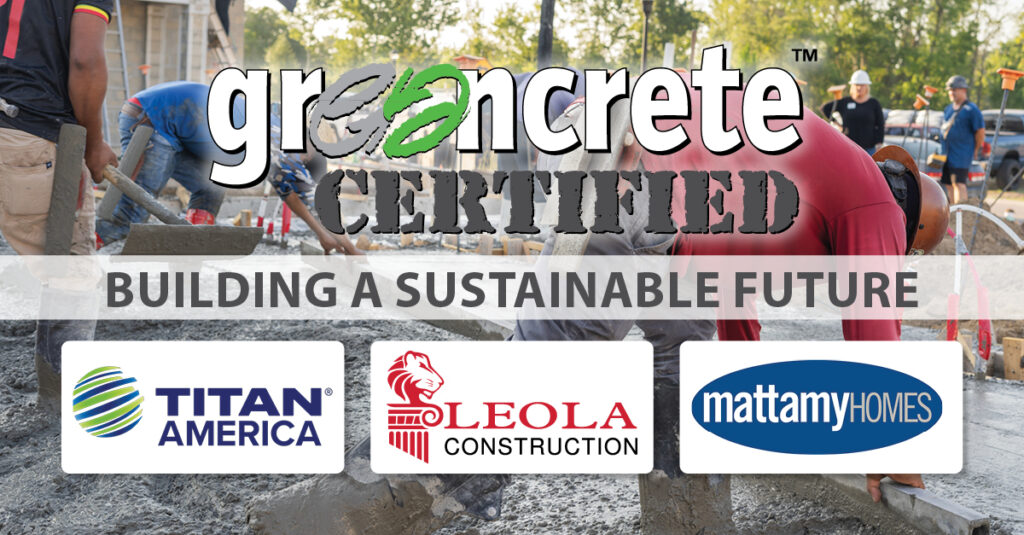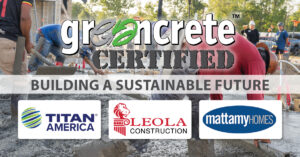As the global construction industry expands, the demand for sustainable and eco-friendly building materials has reached a tipping point. Sustainable construction practices reduce the environmental impact of building projects and contribute to the well-being of communities and the planet. Pioneers in the industry, Titan America, Leola Construction, and Mattamy Homes, have forged a powerful alliance to champion eco-friendly building solutions. They advocate using innovative materials like GreenCrete® concrete in constructing Mattamy Homes, thereby setting a new standard for environmentally conscious building practices. This partnership underscores the pivotal role that eco-friendly building materials play in shaping a sustainable future for generations to come.
The Need for Eco-Friendly Building Materials
The environmental impact of traditional building materials is a grave concern, given their significant contribution to carbon emissions, deforestation, and energy consumption. Materials such as concrete, steel, and glass guzzle enormous amounts of energy during production, leading to alarming greenhouse gas emissions. Moreover, the extraction and processing of these materials often result in the obliteration of habitats and loss of biodiversity. The transportation of these heavy materials further exacerbates their already substantial carbon footprint. Consequently, there is a mounting interest in exploring alternative, more sustainable building materials to mitigate the environmental impact of construction.
The demand for sustainable construction practices has seen a noticeable surge in recent years. More and more individuals, businesses, and governments are recognizing the importance of adopting environmentally friendly methods in the construction industry. This shift is driven by a desire to reduce the environmental impact of construction projects, conserve resources, and create healthier and more efficient buildings. Sustainable construction practices benefit the environment and contribute to long-term cost savings and improved quality of life. As awareness of the need for sustainable practices grows, the demand for eco-friendly construction solutions will only increase.
GreenCrete® by Titan: An Eco-Friendly Solution
GreenCrete® by Titan is an innovative building material that aligns perfectly with sustainable building practices. It is made from recycled materials and industrial by-products, reducing the demand for new resources and minimizing waste. GreenCrete® also offers excellent thermal insulation properties, which can help reduce energy consumption for building heating and cooling. Its production generates lower carbon emissions than traditional concrete, making it a more environmentally friendly choice. With GreenCrete®, you can choose from various CO2 reduction levels to tailor the concrete to meet your specific sustainability objectives. Titan also provides Environmental Product Declarations (EPDs) for all their GreenCrete® products to guarantee the validity of their CO2 reductions, underscoring their dedication to sustainability and accountability.
Titan continuously innovates to minimize its environmental impact by adopting more sustainable construction practices. Several promising techniques and materials are being adopted to achieve this goal. One such approach involves using strength-enhancing admixtures, which involve the injection of silicate nanoparticles to accelerate hydration and enable a reduction in cement usage, resulting in a global warming potential (GWP) reduction of up to 10% per cubic yard of concrete. Similarly, with its optimized particle packing and chemical reactions, Type IL Cement can contribute to a 10% reduction in GWP. In addition, the incorporation of fly ash and slag, potentially reducing GWP by up to 80% per cubic yard of concrete, is gaining traction, especially with ASTM/ACI approval. Enhanced quality control processes and the reduction and recycling of returned concrete are also making strides in reducing environmental impact, with GWP reductions of up to 10% each. These innovative approaches and their respective approvals pave the way for more sustainable concrete practices.
Setting the Standard: The Collaboration Among Titan, Leola, and Mattamy
The collaboration between Titan America and Leola Construction to use GreenCrete® in building Mattamy Homes represents a significant step towards promoting sustainable construction practices. By incorporating GreenCrete® into the construction process, the partnership aims to reduce environmental impact and increase energy efficiency. This collaboration showcases a commitment to environmental stewardship and serves as a model for the construction industry, demonstrating how innovative materials and strategic partnerships can contribute to sustainable development. With a focus on reducing carbon emissions and promoting eco-friendly construction solutions, the collaboration between Titan America and Leola Construction sets a commendable example for the industry.
Challenges and Strategies in Implementing GreenCrete®
Integrating GreenCrete® into construction projects may present specific challenges, such as the initial cost of transitioning to eco-friendly materials and ensuring a consistent supply. To address these challenges, the partnership between Titan America, Leola Construction, and Mattamy Homes plans to emphasize the long-term cost savings and environmental advantages of GreenCrete®. They aim to establish strategic partnerships with suppliers and distributors and offer training programs and resources to construction professionals to streamline the transition to eco-friendly materials. The partnership is committed to overcoming the challenges related to cost, availability, and technical implementation of GreenCrete® to ensure its successful implementation in construction projects.
The Impact on the Community and Environment
The collaboration between Titan, Leola, and Mattamy is a compelling model for upcoming construction endeavors, highlighting the practicality and advantages of integrating eco-friendly approaches into construction processes. This partnership underscores the potential for cooperation between companies to implement sustainable solutions and paves the way for a future marked by environmentally conscious construction practices. By sharing their experiences and achievements, Titan, Leola, and Mattamy can motivate other construction firms to prioritize using eco-friendly materials and methods, fostering a more sustainable industry.
Prospects and Conclusion
The construction industry increasingly recognizes the importance of eco-friendly building materials in creating sustainable and environmentally responsible structures. With growing concerns about climate change and the depletion of natural resources, there is a pressing need for broader adoption of eco-friendly building materials. These materials, such as recycled steel, reclaimed wood, and low-impact insulation, offer significant benefits regarding reduced environmental impact and improved energy efficiency.
One critical insight into the potential for broader adoption of eco-friendly building materials is their increasing availability and affordability. Manufacturers and suppliers are responding to the demand for sustainable construction solutions by producing a more comprehensive range of eco-friendly building materials, making them more accessible to builders and developers. Additionally, advancements in technology and innovation have led to the development of high-performance, eco-friendly materials that meet and often exceed the standards of traditional construction materials.
Furthermore, the shift towards eco-friendly building materials is also being driven by consumer preferences and regulatory requirements. As more individuals and organizations prioritize sustainability, there is a growing market demand for buildings and structures constructed using environmentally friendly materials. In response, many local and national governments are implementing regulations and incentives to promote the use of eco-friendly building materials, further encouraging their adoption across the construction industry.
In conclusion, the potential for broader adoption of eco-friendly building materials in the construction industry is significant. All stakeholders, including architects, builders, developers, and policymakers, should embrace and promote eco-friendly materials in construction projects to ensure a sustainable future. By prioritizing using these materials, we can minimize the environmental impact of construction activities, reduce energy consumption, and contribute to creating healthier and more sustainable built environments. It is time to act and commit to more sustainable construction practices for the benefit of present and future generations.
Learn more at https://www.titan-cement.com/net-zero/ or read Titan’s Integrated Annual Report 2023 at https://www.titan-cement.com/integrated_annual_report_2023_EN.pdf.




